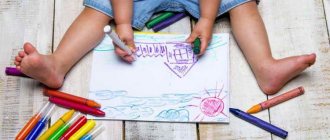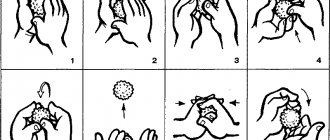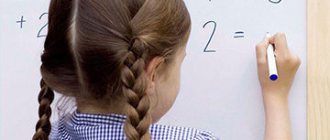Techniques for teaching a child to draw. Pictures that help you learn to draw objects, animals and people.
- Every mother wants to raise her child to be at least a talented and successful person. On the way to this dream, women strive to comprehensively develop their children, invest in them maximum knowledge and teach them as many skills and abilities as possible.
- One of these skills is the ability to draw. Many kids get quite upset due to their lack of artistic talent.
- In this article we will try to figure out how to teach a baby to draw certain things and animate objects.
How to gradually teach a child to draw at 3-4 years old?
How to teach a 3-4 year old child to draw step by step?
Step-by-step learning to draw a child with a pencil or pen:
- At the age of 3-4 years, the baby still cannot press hard enough on a pencil, so we select soft pencils for him. Such pencils are capable of leaving marks behind them even after very light pressure.
- We demonstrate to the child how to hold a pencil in his hand correctly. If the child is unable to pick up a pencil on his own, we help him with this. Subsequently, we constantly ensure that the baby holds a pen or pencil in his hand correctly.
- The first stage of training will be to instill the skill of drawing an even and clear line. At this age, kids are still quite uncertain when holding a pencil in their hand. Therefore, their lines turn out uneven and intermittent. We teach the baby to draw a line confidently and evenly
- It is advisable to purchase a special notebook for your child to trace pictures. In such notebooks, all drawings are depicted using numerous dots. The baby just needs to connect all the dots with one line. The result is a beautiful drawing.
- At first, we help the child trace the pictures, guiding his brush with our hand. Later, we let the baby independently connect all the dots on the piece of paper.
- At the next stage, we teach the child to draw the simplest geometric shapes - circle, square, rectangle, triangle, oval, trapezoid.
- When the baby learns to draw simple figures, we teach him to create drawings from them. For example, using a square and a triangle we draw a house, using a circle and straight lines - the sun, using a rectangle and circles - a bus, etc.
- You can purchase or print children's drawing books from the Internet. In such manuals, various animals and objects familiar to children, created from simple figures, are gradually depicted. Subsequently, the child himself will learn to break all objects into shapes and create whole pictures using this technique.
Features of organizing a workspace for a baby
It is very important to organize a workspace for the baby in the children's room, in which he will be comfortable and interested in studying. A properly equipped workplace sets the child in the right mood.
During drawing lessons for 3-year-old children, it is advisable for parents to be nearby to answer the child’s questions and help overcome difficulties if any arise.
All creative materials - albums, paints, brushes, pencils - should have their own place, and the child should have free access to them. If parents decide to hang shelves or cabinets on the walls, then it is recommended to do this at the height of the baby, so that if he wants, he can easily get something from them.
How to teach a child to count - effective and proven methods
When children 3-4 years old are taught to draw, a chalk board or a wall coated with special paint will become a useful interior detail.
Note! Displays on the walls of the room from works made by the child will add motivation to work.
How to teach a child to draw at 5-7 years old?
How to teach a child to draw at 5-7 years old?
- If by the age of five the child has already completed the pencil training described above, you can begin the next stages of developing drawing skills
- Now you can expand your little one’s creativity with the help of colored pencils, markers and paints. It is necessary to explain to the child that after sketching a drawing with a pencil, he can color it
- On a large sheet of paper, the baby can now create entire compositions and interconnected plots
- An ordinary walk on the street can be an excellent help for the development of a child’s imagination. You simply need to ask the baby to capture in his memory pictures that are interesting to him for later displaying them on a sheet of paper. The baby will then very carefully and intently examine the objects around him in order to remember them. Parents can give their child some tips. To do this, you can ask him leading questions like: “What color is this or that object? What are its dimensions? What is the ratio of the sizes of several objects that the baby likes? What do objects feel like to the touch, according to the baby?”
- All this will help the child to imprint interesting moments in his memory as best as possible, and then express them on paper.
Representation in the drawing of what a child of 5-7 years old saw earlier
- Upon arriving home from a walk, it is advisable to immediately give the baby all the items necessary for drawing and provide him with a place convenient for creativity.
- If your child suddenly has any questions, you need to help him find answers to them.
- Parents can also ask their child questions about what he intends to portray. You can ask what sensations the child experiences, trying to draw what he saw earlier
- In such classes, you can give your child the right to express his emotions and show them through drawing. For example, you can ask your little one to draw his favorite animal in different moods. That is, the child’s task is to show how the dog laughs, how angry it is, how afraid it is of something. Such lessons will develop the child’s imagination and at the same time express the state of his psyche
Album “Options for non-traditional drawing techniques with children 4-5 years old
State budgetary preschool educational institution kindergarten No. 43, Kolpinsky district of St. Petersburg
Options for non-traditional drawing techniques with children 4-5 years old
Prepared by the teacher:
Gurina. A.A.
St. Petersburg, Kolpino
2020
Finger painting (fingergraphy)
Tactile sensations are, along with visual impressions, the leading way of understanding objects and phenomena around us. Therefore, special attention is paid to fingergraphy in kindergarten. But if in the younger groups children made dotted strokes, for example, painted peas on an umbrella, then in the middle group the children learn to draw lines, spots of different sizes, strokes, and also paint over certain elements of the drawing.
At the beginning of the year, children in the middle group repeat making dots with their fingers and train the skill of making round elements
In the middle group, the practice of finger drawing according to a pattern is introduced. The teacher tells, shows and hangs up an algorithm of actions on the board, how to draw an animal or a person using prints and dots-squiggles made with a pencil.
Schemes of step-by-step finger painting are presented in the book by I. Molnar “Imprint, dot, stroke. We paint with our fingers."
For fingerprinting, gouache is usually used, since it does not require dilution with water, is thick and produces bright shades. However, you can also use special hypoallergenic paints for finger painting, as well as watercolors. When working with the latter, before dipping your finger into the paint, you need to moisten it with water or drop some water into a container with watercolors.
Finger painting technique
The sequence of work in the fingergraphy technique is as follows:
- Dip your finger into the paint can.
- Using each finger we pick up paints of different shades. Remove excess with a damp cloth.
- Using your fingertips, apply the design to the sheet.
- After finishing work, wash your hands with soap.
In addition to berries and leaves, kids can also use their fingers to draw lines to depict branches.
Palm painting
As with finger painting, palm painting involves creating an imprint and adding to it using brushes. In the middle group, the imprint becomes the basis for creating various objects: birds, foliage, fish, etc. In addition, with your palms you can create elements such as leaves on trees, flowers in a vase, hedgehog needles, etc.
Palm drawing technique
For palm painting, the drawing algorithm will be as follows:
1. Place your palm in the saucer with paint. In the second semester, children learn to create multi-colored prints with one hand, so the paint will be applied with a brush held in their free hand. The skill of such multi-colored prints is developed in lessons on the topic “Bullfinch”, “Butterfly”, etc.
2. Press your palm firmly against the sheet, if necessary, slightly turn it in a circle, horizontally or vertically.
3.After finishing work, wash your hands with soap.
Drawing birds with their palms, the children add details made with a brush - beak, legs
Poking drawing
This technique is indispensable when creating “fluffy” or “spiky” images. Needles on a hedgehog, fur on a kitten, Christmas trees, dandelions - all these images acquire a special flavor thanks to the poking technique.
Poking technique
To create a poke:
- Place a dry brush with stiff bristles into a jar of gouache.
- Holding the brush vertically, we make a sharp blow to the paper.
- Rinse the brush and blot with a napkin.
The poke can only be done with a dry or semi-dry brush.
Toothbrush painting technique
To obtain voluminous, multi-layered designs, a toothbrush is used. Having collected the paint, we brush it across the sheet, focusing on the design.
In the middle group, drawing with a toothbrush is usually combined with the use of the poking method, appliqué or drawing with cotton swabs.
Toothbrush drawings in the middle group are usually made on a colored background
Monotype
This unconventional technique involves creating a picture by imprinting part of the design on the blank half of a folded sheet. At the age of 4–5, through monotype, children begin to master landscapes, which they will work with in older groups, train the ability to find the middle of an object, and develop the skill of seeing symmetry.
At the same time, not only symmetrical, but also paired objects are created in this way. To do this, a whole image is drawn on one half of the sheet, which is also completely printed on the second side.
Monotype technique
To create a monotype image:
- We bend the sheet in the middle - vertically or horizontally, depending on the location of the depicted object.
- Unbend and draw a picture on one half.
- We bend the sheet again and iron it with our hands.
- We expand and supplement the resulting image with the necessary elements. For example, let’s make a blue background for a river in which a forest is displayed.
In the drawing of a forest reflected in a lake, after unfolding the sheet, children draw a green strip of grass.
Spray
The essence of the technique is that kids pick up paint with a brush or comb, and, pointing it at the sheet, run a pencil along the bristles, thus painting the space of the drawing.
To create a one-color image from several elements, stencils are applied simultaneously
In the middle group, children become familiar with the concepts of foreground and background. For this, the multilayer spray method, which involves the use of stencils, will be an indispensable assistant.
Methodology for working with multi-layer spraying
To make a multi-layer spray:
- We attach the stencil to the sheet using paper clips.
- Take the paint with a brush.
- Let's spray.
- Apply another stencil.
- Spray a different color.
- We remove the stencils - the image turned out to be voluminous and multifaceted.
For multi-layer spraying, you can use stencils of the same image, but of different sizes, then you will get a flickering effect
Scratch
The technique involves scratching image lines on a paper substrate coated with paint according to a pattern previously applied with wax crayons.
Grattage technique
The procedure for creating a grattage drawing will be as follows:
- Color the drawing with wax crayons.
- Fill the surface of the sheet with black paint or ink.
- Leave to dry.
- Using a stick with a sharp end (for example, a wooden kebab skewer), we scratch the lines to reveal the design.
Drawing through gauze
Drawing through wet gauze does not require the use of unusual tools; the picture is created with a brush and paints.
Technique for drawing through gauze
To create a drawing using the original technique:
- We moisten the sheet with pieces of wet cotton wool or cotton pads.
- Place gauze on the paper and straighten it well.
- We create the drawing as usual.
- Let it dry, remove the gauze - the image becomes textured.
When painting through gauze, you need to apply the paint generously, as some of the “color” will disappear after removing the fabric.
Drawing with glue and semolina
We mark the indicated contours of the drawing with glue, pour in semolina and press it on top with a clean sheet. Remove the top sheet and shake off the remaining cereal. The elements are filled in one by one.
In the middle group, with this type of drawing, kids practice the ability to outline a stencil and apply glue exactly within the boundaries of the image.
The substrate for drawing semolina should be colored, since the grain will be invisible against a white background.
Wax painting
In the middle group, kids draw lines, spots and simple geometric shapes with a candle.
Wax painting technique
To create a candle design:
- We draw the outlines of the design on a white sheet with a candle.
- Paint the sheet with any colors.
- The wax lines remain unpainted and appear on the substrate.
Drawing with a wax candle is usually used in winter-themed lessons.
A variation of this technique is drawing with wax crayons. The process technology will be the same, but the wax pencils are multi-colored, so the drawings after filling with paint will be brighter.
For painting with wax, it is better to take watercolor paper, since children may not calculate the degree of moisture in the brush, and the sheet may break through.
Blotography
The essence of the technique is to obtain pictures based on spots and blots. Spots can either be used to decorate a design as intended, or can be used as a basis for an image in a traditional style.
Blotography technique
To create blots:
- Dip the wet brush into the paint.
- Make a stain or place a drop.
- Blow from a cocktail straw onto the paint, blowing it in the desired direction.
In the middle group, kids learn to inflate thin elements from a spot, for example, tree branches
Drawing with foam rubber
To highlight the texture of the depicted object - clusters of flowers, curly clouds - the method of applying paint with foam rubber (or a piece of sponge) is used. To prevent the sponge from getting your hands dirty, it is clamped with a clothespin that acts as a handle.
Stamping technique using natural materials
A whole vegetable (onion, corn, potato, cucumber, etc.) or fruit, berry (apple, lemon, feijoa, etc.), cut in half, flowers (daisies), shells, is painted and an imprint is created on paper. This technique is convenient for drawing cross-sections of fruits and vegetables. For example, to create the composition “Grandma’s Compote,” kids draw the outlines of a pan with a pencil, and depict fruits with stamps.
How to teach how to draw a tree?
How to learn to draw a tree?
- Any tree always consists of a trunk, branches and greenery
- You need to start drawing a tree from the trunk. It is worth noting that the tree trunk expands from top to bottom. In other words, the base of the tree is thicker at the bottom and tapers towards the top.
- The same applies to tree branches - at the base they are thicker, and towards their end they become narrower
- The thickness of the trunk depends on the type of tree. If you want to draw a birch, then the trunk should be thin with bends; if you want to draw an oak, then the trunk should be thick and massive
How to learn to draw a birch?
- After the trunk is drawn, it is necessary to cover it with branches. As a rule, the branches of a tree do not start from the root, but from a quarter of its height. The lower branches are usually depicted wider than the upper ones
- The direction of the branches is always upward - they seem to stretch towards the sun
- On large branches you can draw smaller branches
- The crown can be drawn as a solid mass using paints, or it can be drawn with a pencil in the form of individual leaves
- When all the elements of the tree are drawn, all that remains is to paint it over. To depict a tree, you will need at least two colors: trunk and branches - brown or black, crown - green
Online drawing school Lil School
Website : https://lil.school Phone Cost : online school - 1990 rubles/month, video courses - from 1190 rubles.
Teaching children (5-12 years old) drawing in an online school. Video lessons are pre-recorded; for classes you only need a device with Internet access. After each lesson, the child receives a result - a finished drawing.
Schedule:
- On weekdays from September 1 to May 31 - five lessons per week
- Summer drawing camp lessons: from June 1 to August 31 - three lessons per week
The online school offers five disciplines:
- Monday - illustration
- Tuesday – plasticine painting
- Wednesday - watercolor
- Thursday - creative thinking
- Friday - zenart
- The drawing camp has a lightweight program - a mix of three disciplines every month
The school also has various creative video courses for children of different ages.
How to draw animals?
As mentioned above, to make drawing animals easier, their body must be visually divided into simple geometric shapes. Having drawn each of the figures one by one, you need to connect them with smooth lines. This is how animals are made.
How to learn to draw a fish?
How to draw a mouse?
How to learn to draw a donkey?
How to draw a duck?
How to draw a puppy?
Drawing course from KRAFTi
Website : https://krafti.ru Phone : no Cost : free trial lesson, from 2990 RUR/access for 3 months.
Children's drawing course from KRAFTi 4-10 years old
The course consists of 18 lessons, where each lesson is a finished painting. You will also find 16 scientific lectures about those animals, plants and phenomena that the child draws. And one more bonus - for parents - 2 lectures from a professional psychologist who will answer the most pressing questions about the relationship between creativity and children's development.
The lessons are combined into blocks in accordance with the techniques being studied. Children will get acquainted with the concept of composition, why a pencil sketch is needed, learn to get the right shades by mixing paints, draw details using different techniques, draw a beautiful background, transitions, and get acquainted with the laws of light and shadow.
At the end of each block, young artists will have homework. When all tasks are completed, a gift from KRAFTi will open - a bonus lesson with a lecture.
How to teach a child to draw a person?
How to teach a child to draw a person?
It would seem that drawing a person is very difficult. However, if you adhere to a certain scheme, even a preschool child can cope with this task. So, step by step drawing of a person:
- Draw an oval. The oval will later become a human head
- Under the oval we draw a rectangle that will act as the upper part of the human body (to the waist)
- We connect the oval and rectangle with two smooth lines. Thus we draw the neck
- Draw a second rectangle adjacent to the rectangle. Its width should be equal to the width of the first rectangle, but in length it will be slightly more oblong
- We divide the second rectangle in half with a line running exactly in the center from top to bottom. This line will help us create some semblance of legs
- Along the first rectangle we draw one more thin rectangle. This is how we draw the hands
- Smooth the upper part of the rectangles with a smooth line - these will be the shoulders
- Now we draw the neck of the sweater, the triangle on the pants, shoes and hands. All extra lines need to be erased with an eraser.
- If desired, you can draw the boy's eyes, mouth, nose, ears, eyebrows and hair
Simple drawing of a man
The benefits of drawing
Creative activities are an important element in the development of a child. Preschool children are characterized by visual-figurative thinking, so drawing lessons are of great importance at this age stage.
Drawing helps in the development of:
- imagination;
- abstract logical thinking;
- fine motor skills;
- logic;
- creative thinking;
- attentiveness.
Drawing is also a reason to spend more time with your baby, which has a significant impact on his psycho-emotional development.
Online school of handicrafts and drawing SkillBerry
Website : https://lp.skillberry.ru Phone : no Cost : course - from 770 rubles, all-inclusive subscription - from 490 rubles / month.
You can purchase a course on a topic of interest separately (access for 1 year) or buy a subscription for 1 month with access to all courses and video lessons on the platform. Every month they add at least 2 new courses and at least 30 new video lessons on drawing for adults and children.
Courses for children 3-10 years old:
- Drawing for children 3-8 years old
- Nature, trees and plants
- Dinosaurs and Dragons
- Cartoon characters
- Animals
- Undersea world
- LOL dolls
- Drawing and crafts for children 3-8 years old
- Modeling and Drawing with plasticine for children 3-8 years old
- Gouache drawing for children 5-11 years old
- Learning to Draw Landscapes
- Learn to draw Space
- Seasons
- New Year cards
- Drawing Spring
- Step-by-step techniques for drawing Underwater inhabitants
- Studying foreign literature
- Circus
- Kinds of sports
- Pets. Online course on modeling for children
Courses for children 10+ years old and adults:
- Oil painting from scratch to professional
- Learning to make postcards
- Zentangle and doodling. Full course
- Interior sketching
- Gouache painting from scratch to professional
- We draw landscapes in different styles
- We draw still lifes in different styles
- Drawing with pastels from scratch to professional
- Watercolor painting from scratch to professional
At a convenient pace, at a convenient time, you watch lessons recorded by a professional artist-teacher, complete tasks and post them in your office. You receive feedback on every task.
Online drawing school Artist Online
Website : https://www.hudozhnik.online Phone Cost : from 1900 rubles/course
For children:
“Basics of drawing for children 5-9 years old” Special program for the little ones. Children will learn the basics of color theory, learn several painting techniques, and practice new knowledge on exciting tasks.
“Drawing Masterpieces: Course for Children 7-12 Years Old” Large course on art history. Each lesson is a story about one of the significant stages in the development of art and a fascinating task to reinforce the material: from the Stone Age to the 20th century.
“Watercolors and pencils: course for children 6-11 years old” Children's course on watercolor painting and drawing with colored pencils.
Self-paced learning or with feedback is possible for 12 months, access forever. The teacher communicates with you in writing and in weekly live webinars. Each of your work is analyzed. After completing the course you will receive a special certificate.
Online drawing school MagicArt School
Website : https://magicart.school Phone : no Cost : free trial lesson, lessons - from 200 rubles, courses - from 500 rubles.
Each of the courses is developed by experienced teachers using their own methodology, thanks to which any student, regardless of experience and skills, can learn to draw in 30 minutes a day. Upon completion of the course, a personal certificate is issued.
Thematic courses for children aged 3-7 years:
- Dinosaurs (5 lessons)
- For boys' creativity (5 lessons)
- For girls' creativity (5 lessons)
- Magic watercolor (10 lessons)
- Striped course 3+ (5 lessons)
- Secrets of space (5 lessons)
- Creative collage (10 lessons)
- Magic gouache (10 lessons)
- For the little ones 3+ (5 lessons)
- Who said meow?! 3+ (3 lessons)
- Funny dogs 3+ (3 lessons)
- Pirate riddles (5 lessons)
- Mexico (5 lessons)
- Important professions (5 lessons)
- Autumn colors (3 lessons)
- Winter Heroes 3+ (5 lessons)
- Circus! Circus! Circus! (3 lessons)
- Farm trip (3 lessons) and others
Individual lessons can also be purchased.
School of educational drawing Artliner Artliner
Website : https://artlinerschool.ru Phone Cost : from 980 rub.
They teach children aged 4-12 years to draw, introduce them to the work of great artists and broaden their horizons. Each lesson contains 20-30 educational facts about the world around us.
40-60 minutes duration of one lesson. Checking of work and feedback from teachers is provided.
Online drawing courses:
- School tour 4+, 5 lessons
- Easy start 4+, 10 lessons
- Winter stories 7+, 12 lessons
- Magic book 7+, 7 lessons
- Educational drawing 1.0 4+, 30 lessons
- Educational drawing 2.0 6+, 30 lessons
- Educational drawing 3.0 9+, 30 lessons
- Course for boys 6+, 15-30 lessons
- Course for girls 6+, 15-30 lessons
- Great Artists 6+, 15 lessons
Online drawing school “Drawing houses”
Website : https://risuemdoma.com Phone : no Cost : from 1200 rubles/course
Online drawing courses for children:
“Creativity and Creativity”, 3-5 years:
- Beginner 6 video lessons
- Basic 11 video lessons
- Full 17 video lessons
“Basics of drawing and painting”, 6-9 years:
- Beginner 6 video lessons
- Main 10 video lessons
- Advanced 8 video lessons
- Full 24 video lessons
Give your child everything necessary, indicated in the description of the lesson, and sit down to draw. Kids may need your help, but older kids can handle it themselves.
You can watch the lessons at a convenient time; after purchasing, the course is available at any time throughout the year. Take a photo of your child’s work and send it for verification (takes up to 3 days) through your personal account. Upon completion of the full course, a diploma is issued.
Master classes and individual lessons are also available on the site.
What should a child be able to do?
Most children at the age of three can already:
- Run quickly, jump, step over obstacles.
- Pronounce up to 1,500 words and form complex sentences from them.
- Listen to fairy tales for a long time.
- Ask a lot of questions.
- Complete the task without distraction for at least 5 minutes.
- Tell a familiar fairy tale based on the picture.
- Learn poems and songs.
- Pronounce your first and last name, know your age (points on fingers) and gender.
- Show body parts and know their purpose.
- Call yourself "I".
- Say hello, goodbye and say “thank you”.
- Perform 2 actions at the same time, for example, clapping and stomping.
- Play with other children, exchanging toys.
- Ride a 3-wheeled bike, sled, and swing.
- Count to three.
- Become familiar with 7 colors (including white and black) and geometric shapes.
- Assemble toys from 4-6 parts.
- Understand the differences in the size of objects, their shape and weight.
- Draw according to your wishes.
- Fantasize in role-playing games and follow the rules in outdoor games.
- Dress yourself, as well as undress and fold your own clothes.
- Fasten buttons and tie shoelaces.
- Use a handkerchief.
- Eat carefully (not only with a spoon, but also with a fork) and use a napkin.
Stages of development of children's drawings
| Age | Contents of drawings |
| Up to 1.5 years | Stroke stage. At this age, children enjoy the colorful marks they can leave on paper. Provide your child with as many creative materials as possible so he can express himself. |
| 1.5 – 3.5 years | Doodle stage. The drawings made by children at this age do not differ in appearance from the drawings of the previous stage, but the child already puts his own meaning into them, wanting to depict something specific. |
| 3.5 – 8 years | Schematic stage. At this age, children usually begin to draw familiar houses, flowers, and the sun. The child depicts only the important details of the object, without taking into account the proportions. |
| 8 – 10 years | Stage of plausible images. Children at this age try to depict the object as accurately as possible, details are drawn, proportions are taken into account. |
| After 10 years | Correct images. The drawings become three-dimensional and realistic. |
Experts separately highlight the features of children’s depiction of humans:
| Age | Features of the image of a person |
| 4 years | The body is usually round or oval, there is no neck. The proportions are not respected. |
| 5 years | Gender differences appear (girls and boys are depicted differently), details (ears, hair, clothes). |
| 6 years | Drawing small details, maintaining proportions. The neck is shown. |
| 7 years | The drawing becomes more realistic. The face can be drawn not only from the front, but also from the profile. |
| 8 years | The line of the neck, shoulders and arms is continuous. |
| 9 years | A person can be depicted in various poses, and movement is captured. |
| 10-11 years | The desire to create a three-dimensional image. |











